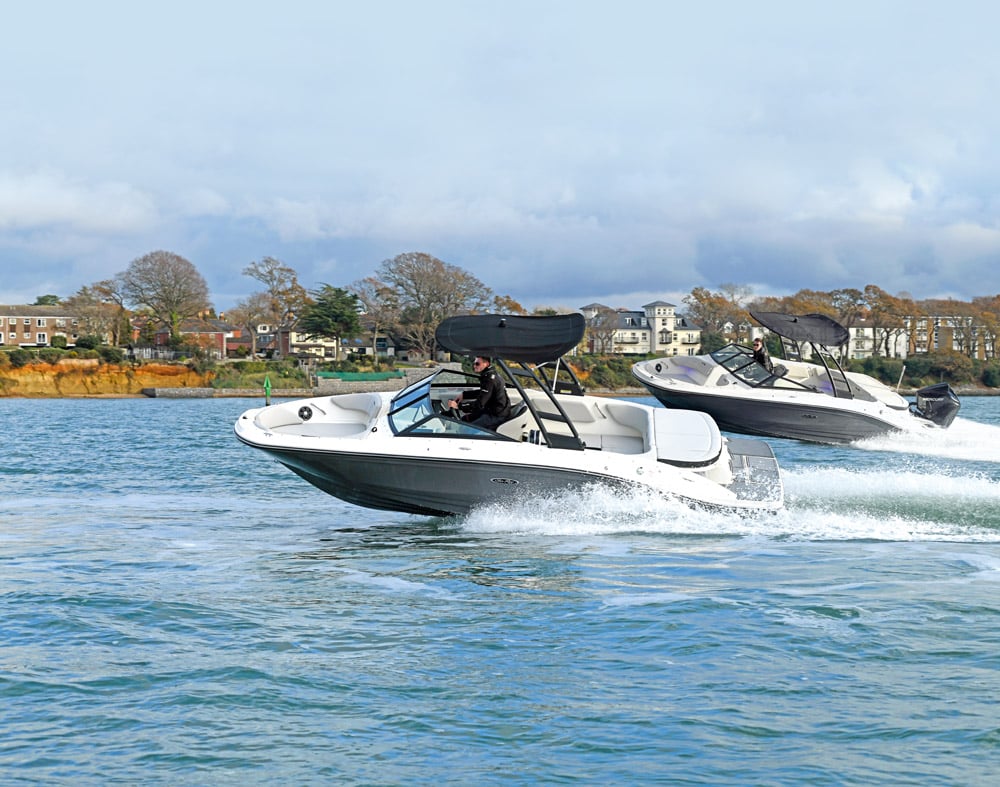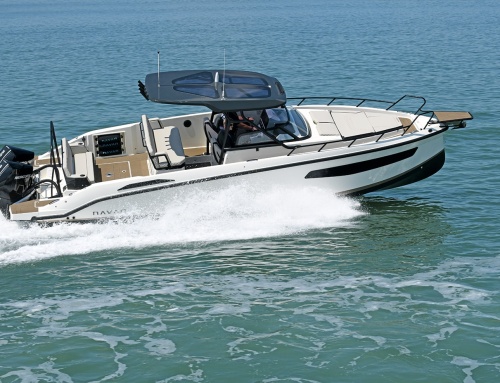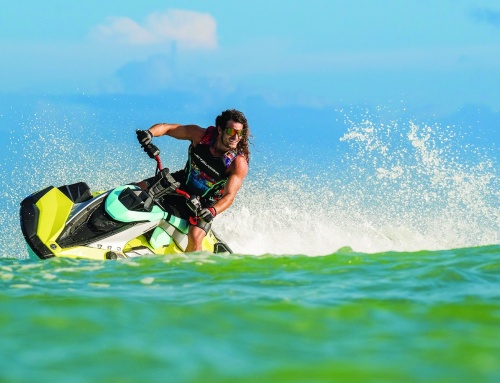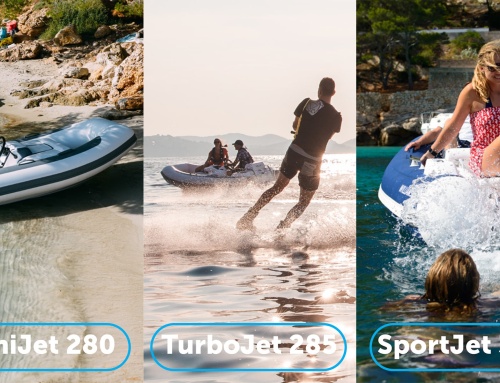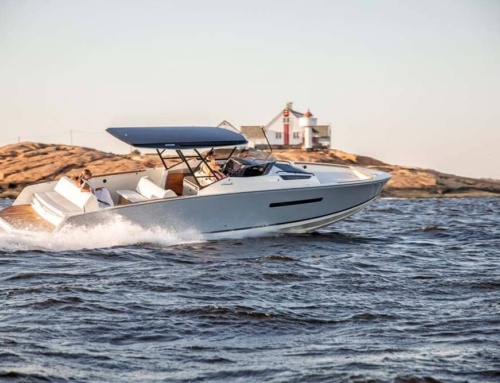With the rise of the big outboard, has the venerable petrol sterndrive had its day? Greg Copp explores this emergent dilemma and is surprised by his findings …
Rarely do we get the chance to test two identical boats with two different engines, in this case outboard and sterndrive. With outboards now taking a bigger slice of the sports boat market, how they stack up against sterndrives of similar output is something we were keen to find out. Luckily, Solent-based Marina Marbella just happened to have two of Sea Ray’s latest sports boats in stock: the outboard-powered 210 SPOe and the sterndriven 210 SPXe – near identical bar their engines. I should point out that the outboard boat had a 200hp V6 Mercury 4-stroke outboard, while the sterndriven Sea Ray had a 250hp V6 MerCruiser MPI Alpha 1, so there was a disparity. However, as outboard engines are rated at the propeller and sterndrives at the crankshaft – losing around 10% power in transmission – these engines are closer than it appears.
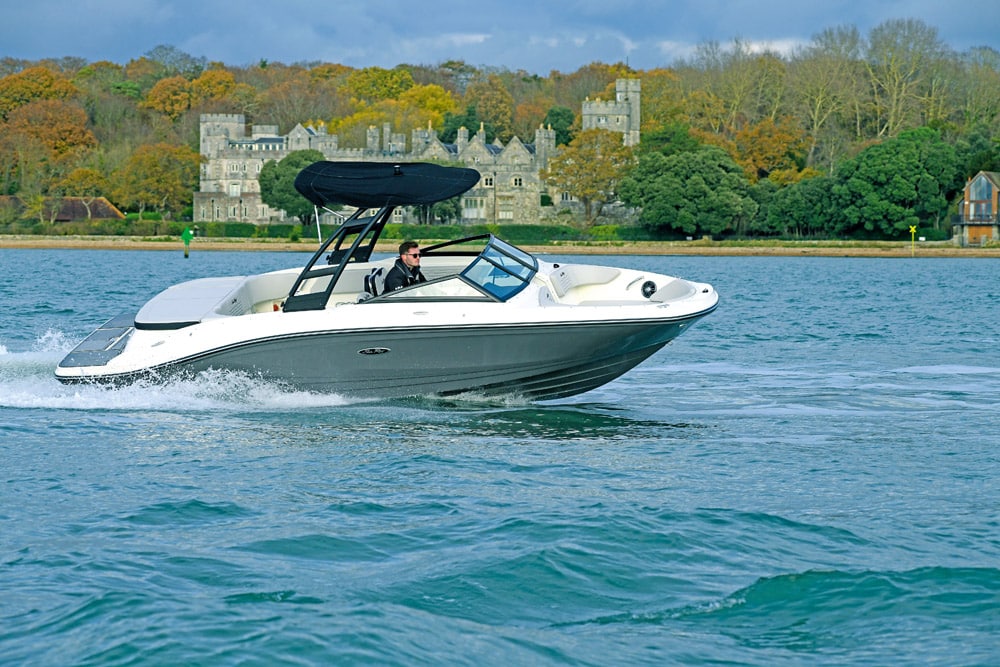
Sterndrive 210 SPXe
The boats
When it comes to petrol-powered open sports boats, the USA has traditionally had a lion’s share of the market, with Sea Ray one of the leading brands. Consequently, both the 210 SPOe and 210 SPXe are well-built boats, which is evident once you start poking around behind the scenes. Lifting the forward seat cushions reveals small storage lockers, which are neatly lined with carpet. Between these is a lined self-draining locker beneath the forepeak seat – ideal for stowing anchor and chain.

The helm set-up works best seating.

The cockpit design provides a good level of protection for all.
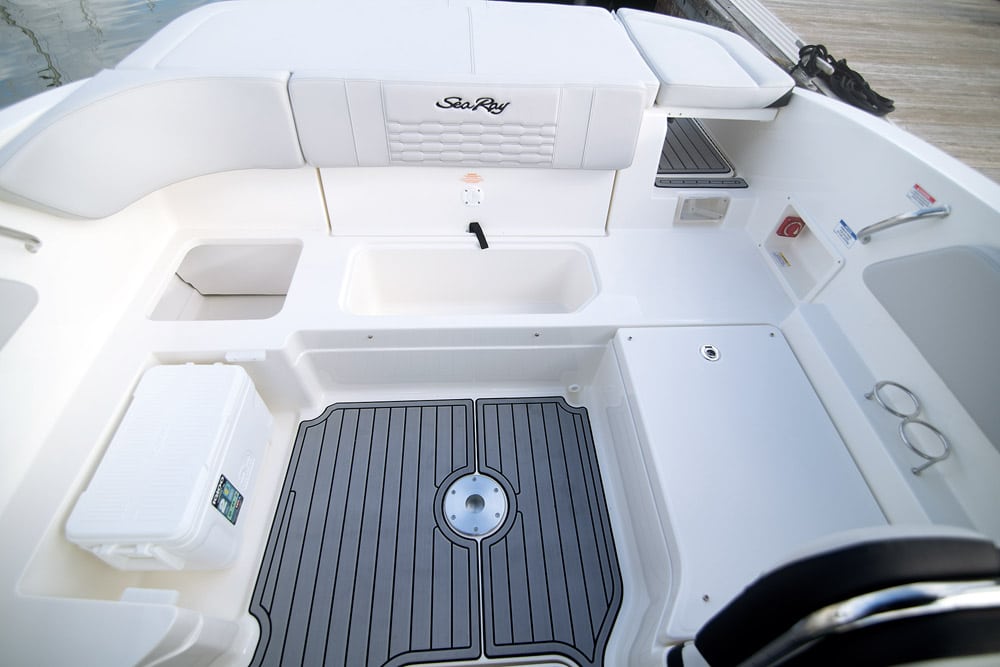
With the seating removed, you have access to quite a bit of storage and the cool box.
Both boats came with the ‘Captain’s package’, which includes a very neat teak table, which when not used is secured safely inside a storage compartment forward of the navigator’s seat. All decking is synthetic grey SeaDek, which inevitably is an extra – in this case, from stem to stern, costing just over £2,000. The upholstery is nicely finished, as is evident in its detailing. All stitching is of a high standard, and the seat bases are finished with a tough mesh, enabling moisture to escape. The securing pop studs can be easily secured to their counterparts, and the seat cushions themselves have triple-density foam, so they instantly retain their composure after use. The navigator’s seat backrest can either fold flat to make a port-side sunbed or it can be set to create an aft-facing recliner – ideal for keeping an eye on any waterskiers. Easy access to the bathing platform can be provided by removing the curved backrest in the port-quarter section of the cockpit seating, which otherwise slots securely into a quick-release mounting. Once removed, the end of the sunbed can be folded up, cushion and all, revealing a walkway. With the sterndriven SPXe version you can opt for the ‘submersible swim platform’, which folds out from the middle section of the bathing platform. It does cost £1,847, but it provides an alternative to climbing back up the typically narrow ladder on the port quarter. It also enables people to sit and dangle their legs in the water, as well as being a bonus for young swimmers.

The SPXe has a big bathing platform for a 21-footer.

All the seat bases around the cockpit can be easily removed – and put back in place with little effort. Only one of the five sections requires pop studs to be secured, with the remaining four being held in situ through the mutual support of the others – and they stay in place. Beneath the aft central section of the seating is located a lined self-draining locker that is ideal for wetsuits, and on the starboard quarter there is a storage cavity. With the seat cushion removed on the port quarter, a texturised surface provides grip for wet feet accessing the bathing platform. The all-important Igloo cool box lies under the starboard seating section, which appeared to be effectively loose during our test without any retaining strap. However, the seat base held it in place, so there were no issues here, though at 20L you might be tempted to shell out £2,000 to complement it with the optional 12V cockpit cool box. Along the centreline of the cockpit sits an under-deck ski locker, which with our test boats was filled with the cockpit and bimini covers. Storing these covers could be a bit of a problem if you had skis to keep in this locker, but if you have the outboard-powered 210 SPOe, things are very different. Having no sterndrive engine to house, the SPOe has a huge amount of storage under the sunbed. This will be a deal clincher for many, especially those with a family to cater for, as this cavity will swallow a good few water toys, and more. One aspect I particularly liked about the hinged locker lids and doors is the powered gas struts that open the lids/doors for you – and the fact that all of the flush stainless catches actually open without a fight.

If wanted, there is a full-length sunbed on the port side.

Carpet-lined forward lockers are a neat touch.

This self-draining anchor lies under the forepeak seat.

Nice and easy battery access in the port quarter.
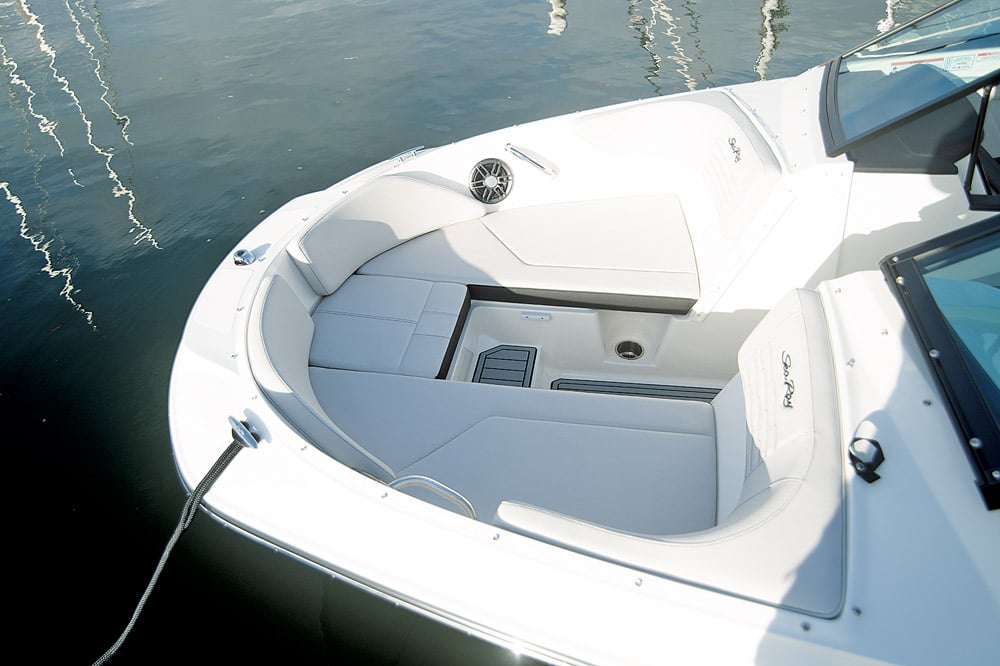
A typical bowrider forward seating area.

A long ski locker lies under the cockpit.
Both boats came with the £5,304 ‘Elevation package’, which includes the water sports tower, bimini top, wakeboard racks and ski mirror – which this craft would be somewhat naked without. The helm consists of a fore/aft adjustable seat and a very nice digital dash fitted with a 9in Simrad MFD. The seating position is low, as is inevitably the case with sports boats like the 210, but if you need to, you can fold up the seat bolster and stand. Happily, the armrest is positioned just where you need it to support your throttle forearm.
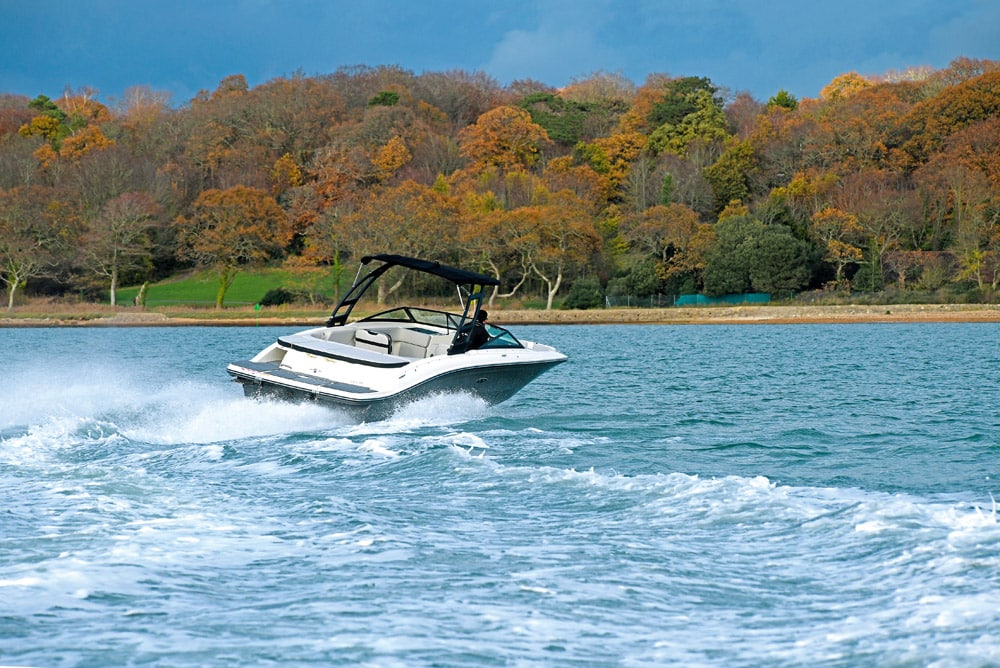
Sterndrive 210 SPXe
Driving the SPXe
One thing you notice about the sterndriven SPXe is that the stern sits lower in the water than with the SPOe. It is some 200kg heavier as a result of the MerCruiser 4.5L V6 engine and sterndrive than the Mercury 3.4L V6 outboard. However, it picks up punching onto the plane with little bow-up attitude and starts to plane around 16 knots. As a result, pulling inflatables at sensible speeds for youngsters is not a problem, but once past 20 knots she settles into a very composed pace, which is ideal for towing skiers.

The 4.5L V6 MerCruiser has good access to all service items.
In terms of performance, she hits 30 knots in 7 seconds. The boat’s natural fore and aft trim is very good – to the point that you can be misled into thinking that she wants little trim out at wide open throttle, which is not the case. If you run her at around 30% trim out, she will just hit 40 knots, but push her past 50% trim out once at 35 knots and you will feel it. The boat will reach just another 2 knots at top speed, but the response to the throttle is a lot better, and the ride is not remotely flighty at the bow as you might expect. At wide open throttle, this beamy boat sits perfectly composed, and with a 19-degree transom deadrise angle she may not be in deep-vee territory, but the hull is still sharp enough for a predominantly soft ride. The forefoot is relatively rakish for a bowrider, and combined with plenty of forward flare, the ride into the wake that we kicked up and the chop we found was pretty good, with little if any water ending up on board.
Tight turns are something at which this boat excels. The steering is quick and reassuring, and like its outboard sibling the SPXe reacts very quickly to engine trim. So when you are bustling along at 35 to 40 knots and want to cut a tight turn, you can trim in very quickly and then track round as if on rails. You will not get any hull slide even in the hardest of turns, and I found that even with quite a bit of trim out, this boat still sits firm in her line. She is simply great fun to throw around, which is a lot of what this boat is all about.
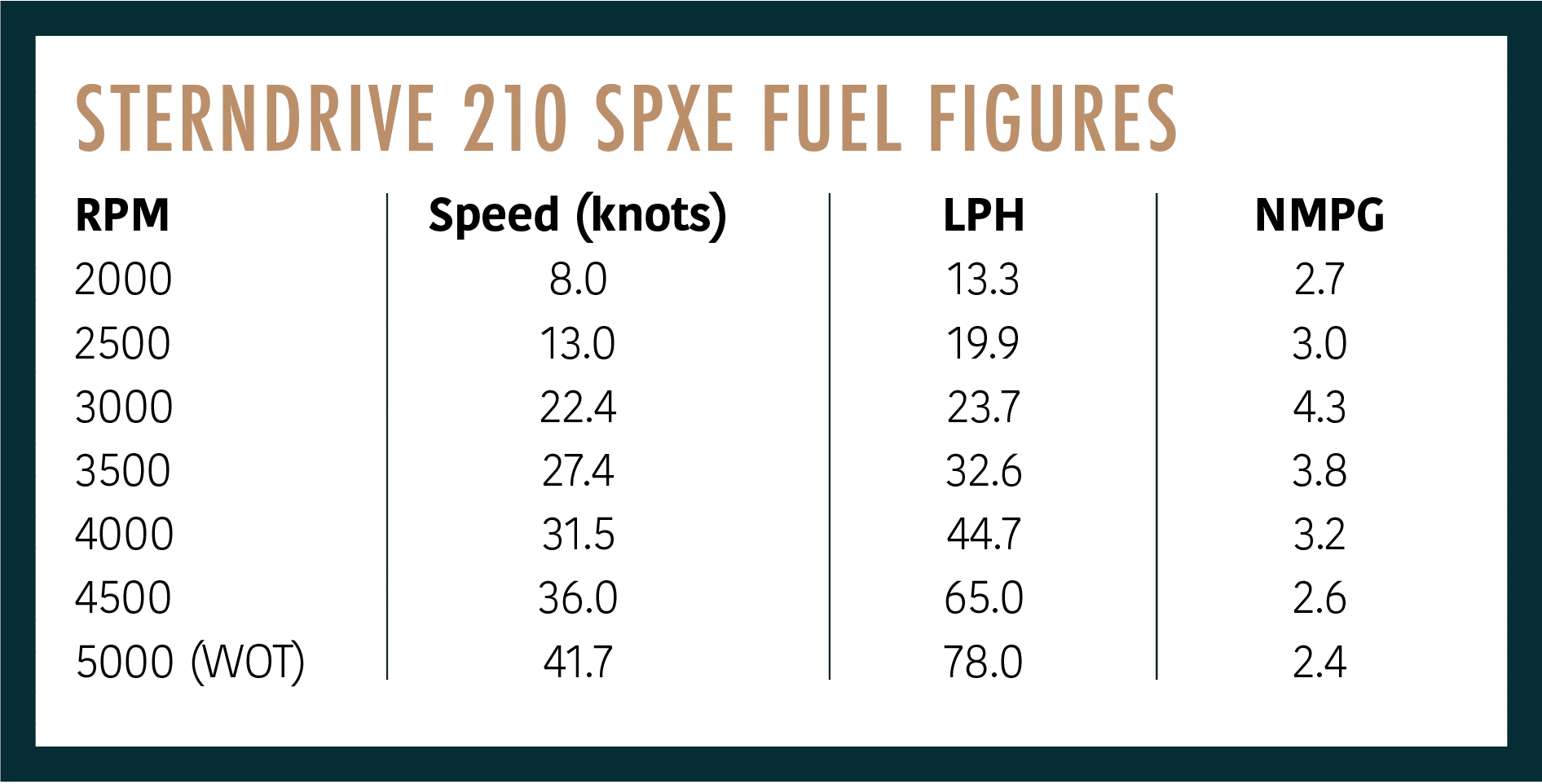
Sterndrive 210 SPXe fuel figures
Specifications
Sterndrive 210 SPXe
- LOA: 6.55m
- Beam: 2.59m
- Draught: 0.91m
- Hull: Medium vee
- Transom deadrise angle: 19 degrees
- Displacement: 1607kg (dry)
- Power options: Single 200hp MerCruiser 4.5L MPI Alpha 1; single 250hp MerCruiser 4.5L MPI Alpha 1
- Fuel capacity: 140L (37 gal)
- Test engine: 250hp MerCruiser MPI Alpha 1
Performance
- 41.7 knots (2-way average), sea conditions F2, crew 3, fuel 40%
- 0–30 knots: 7 seconds
Price
- From: £61,599 (inc. VAT) (200hp MerCruiser MPI Alpha 1)
- As tested: £78,289 (inc. VAT)
Driving the SPOe
I went straight into this boat from the SPXe, and the first thing that struck me was the difference in attitude when powering up onto the plane. It might be slightly lighter having an outboard engine, but all that weight is sitting on the transom, unlike a sterndrive boat, which has a chunk of its engine mass slightly further forward. Is this an issue? Not really, as the SPOe quickly climbs the hump and is off at a rate of knots. She is slightly quicker to 30 knots at 6 seconds, and you can just feel it. Her top speed was nearly 2 knots faster at 43.5 knots, and just like the SPXe, she sits perfectly composed at all speeds. She also reacts to engine trim in the same super-quick manner as the SPXe, and likewise needs around 50% trim out for the last 2 knots or so. However, I did get the impression that her top-end response was not quite as punchy as the power delivery from the 4.5L MerCruiser. Her natural poise is very good, so many will likely leave her at her ‘default point and shoot’ trim setting of 30%. Her ride into whatever seaway we found was likewise very dry, and if you bother to tune your ears to it, you can ascertain that this boat is slightly quieter than its sterndriven sister. However, the SPXe does feel slightly more planted in the water, no doubt due to the extra weight of its engine. You notice it in the wider turns, and to a degree when running through wake or chop. I will say that I probably would not have been able to notice the difference between the two had I not literally jumped from one to another.
In the turns, the SPOe cuts it tighter, but by a small margin. This is likely down to the fact that having an outboard results in a longer overall length, which means that the propeller is further away from the central point of the boat, about which it turns. However, when powering hard out of very tight turns at lower speeds, there is a degree of cavitation not felt on the sterndriven boat.

The SPOe still has access across the bathing platform.

The SPOe has a huge storage area under the sunbed.
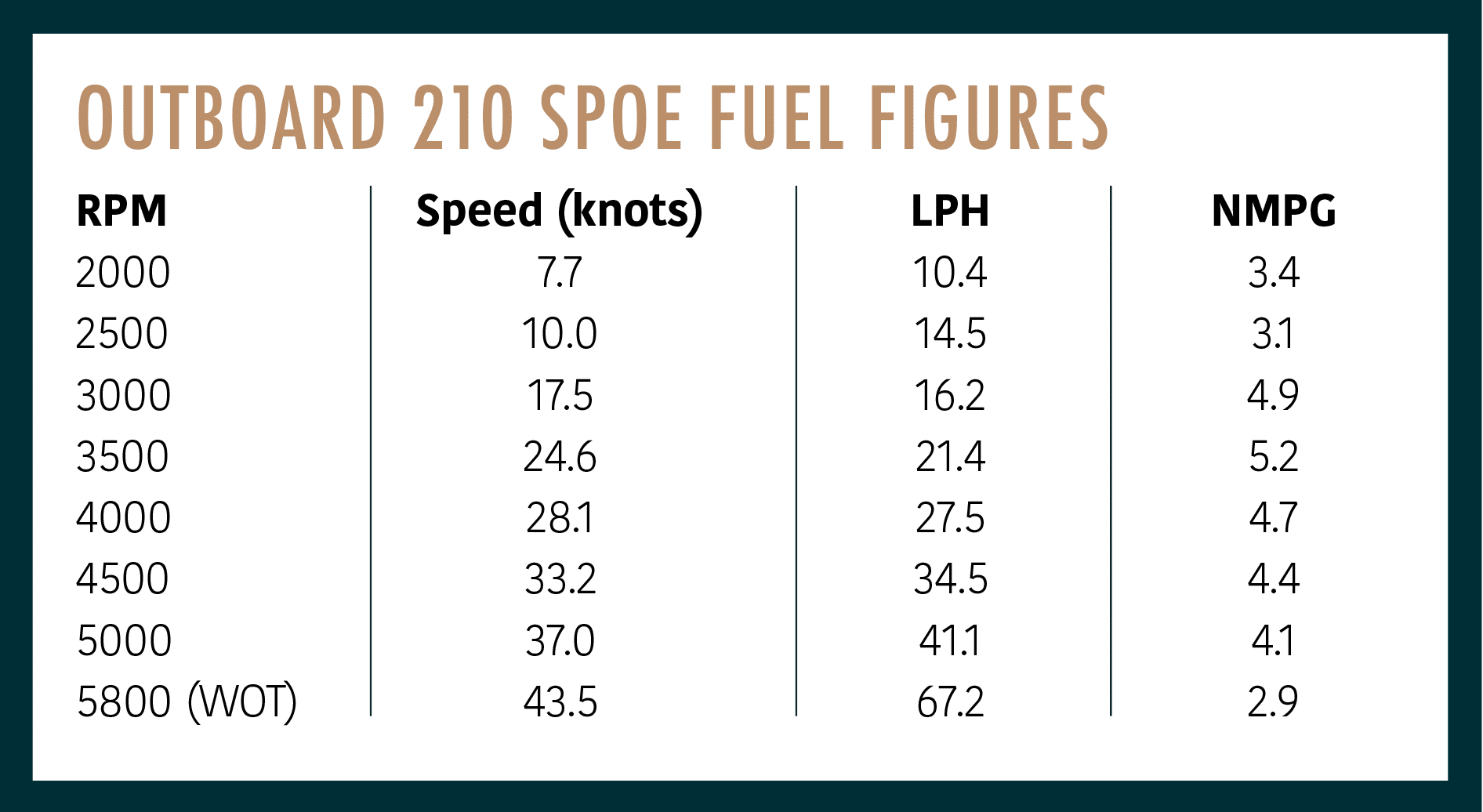
Outboard 210 SPOe fuel figures
Specifications
Outboard 210 SPOe
- LOA: 7.24m
- Beam: 2.59m
- Draught: 0.79m
- Hull: Medium vee
- Transom deadrise angle: 19 degrees
- Displacement: 1399kg (dry)
- Power options: Single 150hp Mercury 4-stroke outboard; single 200hp V6 Mercury 4-stroke outboard
- Fuel capacity: 140L (37 gal)
- Test engine: 200hp V6 Mercury 4-stroke outboard
Performance
- 43.7 knots (2-way average), sea conditions F2, crew 2, fuel 40%
- 0–30 knots: 6 seconds
Price
- From: £62,376 (inc. VAT) (150hp Mercury 4-stroke outboard)
- As tested: £85,171 (inc. VAT)
Price
- From: £62,376 (inc. VAT) (150hp Mercury 4-stroke outboard)
- As tested: £85,171 (inc. VAT)
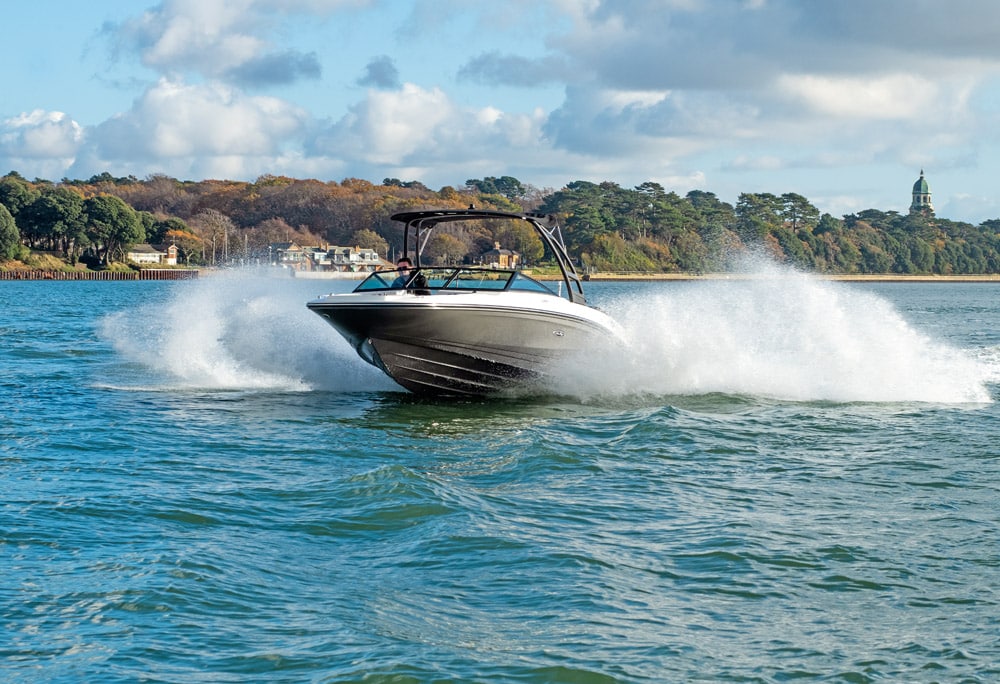
Verdict
I approached this test thinking that the outboard-powered boat would be a clear winner. In terms of economy, the SPOe is the winner, as at speeds of 27 to 28 knots she is 15% more efficient than the SPXe, and at speeds in the late 30s this figure increased to an incredible 37%. Both boats had the same Mercury hardware and software in terms of fuel metering, so this rules out any error in this department. The 4.5L MerCruiser is bigger and an older-generation engine compared to the 3.4L Mercury outboard – a motor that has proven to be very successful since its launch – so the comparison is possibly a bit unfair. However, the sterndrive does provide a slightly better driving experience at higher speeds, with more grunt from its bigger-capacity engine and a slightly more planted feeling in the water. It loses to the outboard in terms of top speed by a small margin, which could be down to something as simple as prop pitch.
In terms of choosing, it has to come down to which boat suits your needs best. The extra storage on the SPOe is very hard to ignore, but then the big bathing platform and the submersible swim platform make a good case for the SPXe. In terms of price, the ‘old school’ sterndrive boat is around £7K cheaper than the outboard-powered 210 SPOe, though in terms of ‘boating value for money’, they are both hard to beat.
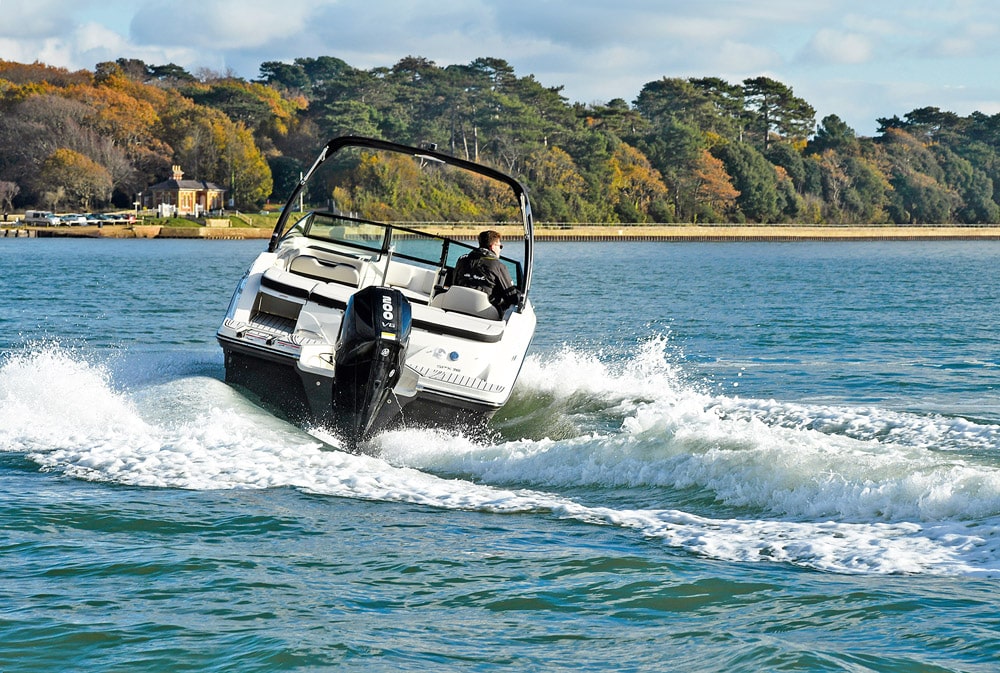
Sea Ray 210 SPOe – The outboard version turns a tad quicker than the sterndrive model.

Contact
Marina Marbella (UK) Ltd
marinamarbella.net/en
01489 576676
Boats.co.uk
www.boats.co.uk
01702 258885
Take a look at our test at Cannes Yachting Festival 2023

